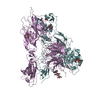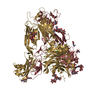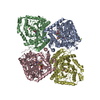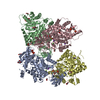+ Open data
Open data
- Basic information
Basic information
| Entry | Database: EMDB / ID: EMD-22283 | |||||||||
|---|---|---|---|---|---|---|---|---|---|---|
| Title | cryo-EM of human GLP-1R bound to non-peptide agonist LY3502970 | |||||||||
 Map data Map data | ||||||||||
 Sample Sample |
| |||||||||
 Keywords Keywords | Class B GPCR / glucagon-like peptide-1 receptor / G protein nucleotide exchange factor. / MEMBRANE PROTEIN | |||||||||
| Function / homology |  Function and homology information Function and homology informationadenylate cyclase-activating serotonin receptor signaling pathway / glucagon-like peptide 1 receptor activity / glucagon receptor activity / sensory perception of chemical stimulus / positive regulation of blood pressure / mu-type opioid receptor binding / hormone secretion / corticotropin-releasing hormone receptor 1 binding / post-translational protein targeting to membrane, translocation / beta-2 adrenergic receptor binding ...adenylate cyclase-activating serotonin receptor signaling pathway / glucagon-like peptide 1 receptor activity / glucagon receptor activity / sensory perception of chemical stimulus / positive regulation of blood pressure / mu-type opioid receptor binding / hormone secretion / corticotropin-releasing hormone receptor 1 binding / post-translational protein targeting to membrane, translocation / beta-2 adrenergic receptor binding / response to psychosocial stress / regulation of heart contraction / peptide hormone binding / PKA activation in glucagon signalling / developmental growth / D1 dopamine receptor binding / activation of adenylate cyclase activity / Hedgehog 'off' state / negative regulation of blood pressure / response to prostaglandin E / insulin-like growth factor receptor binding / adenylate cyclase regulator activity / ionotropic glutamate receptor binding / adenylate cyclase activator activity / bone development / platelet aggregation / G-protein beta/gamma-subunit complex binding / Olfactory Signaling Pathway / Activation of the phototransduction cascade / adenylate cyclase-activating G protein-coupled receptor signaling pathway / G beta:gamma signalling through PLC beta / Presynaptic function of Kainate receptors / Thromboxane signalling through TP receptor / G protein-coupled acetylcholine receptor signaling pathway / Activation of G protein gated Potassium channels / Inhibition of voltage gated Ca2+ channels via Gbeta/gamma subunits / G-protein activation / Prostacyclin signalling through prostacyclin receptor / G beta:gamma signalling through CDC42 / Glucagon signaling in metabolic regulation / G beta:gamma signalling through BTK / Synthesis, secretion, and inactivation of Glucagon-like Peptide-1 (GLP-1) / ADP signalling through P2Y purinoceptor 12 / photoreceptor disc membrane / Sensory perception of sweet, bitter, and umami (glutamate) taste / Glucagon-type ligand receptors / Adrenaline,noradrenaline inhibits insulin secretion / Vasopressin regulates renal water homeostasis via Aquaporins / Glucagon-like Peptide-1 (GLP1) regulates insulin secretion / G alpha (z) signalling events / cellular response to catecholamine stimulus / ADP signalling through P2Y purinoceptor 1 / ADORA2B mediated anti-inflammatory cytokines production / G beta:gamma signalling through PI3Kgamma / transmembrane signaling receptor activity / adenylate cyclase-activating dopamine receptor signaling pathway / Cooperation of PDCL (PhLP1) and TRiC/CCT in G-protein beta folding / GPER1 signaling / Inactivation, recovery and regulation of the phototransduction cascade / cellular response to prostaglandin E stimulus / G-protein beta-subunit binding / heterotrimeric G-protein complex / G alpha (12/13) signalling events / sensory perception of taste / extracellular vesicle / signaling receptor complex adaptor activity / Thrombin signalling through proteinase activated receptors (PARs) / positive regulation of cold-induced thermogenesis / retina development in camera-type eye / G protein activity / positive regulation of cytosolic calcium ion concentration / GTPase binding / Ca2+ pathway / fibroblast proliferation / High laminar flow shear stress activates signaling by PIEZO1 and PECAM1:CDH5:KDR in endothelial cells / G alpha (i) signalling events / G alpha (s) signalling events / phospholipase C-activating G protein-coupled receptor signaling pathway / G alpha (q) signalling events / Hydrolases; Acting on acid anhydrides; Acting on GTP to facilitate cellular and subcellular movement / Ras protein signal transduction / learning or memory / cell surface receptor signaling pathway / Extra-nuclear estrogen signaling / cell population proliferation / apical plasma membrane / G protein-coupled receptor signaling pathway / lysosomal membrane / GTPase activity / synapse / GTP binding / protein-containing complex binding / signal transduction / extracellular exosome / metal ion binding / membrane / plasma membrane / cytoplasm / cytosol Similarity search - Function | |||||||||
| Biological species |  Homo sapiens (human) / Homo sapiens (human) /   | |||||||||
| Method | single particle reconstruction / cryo EM / Resolution: 3.1 Å | |||||||||
 Authors Authors | Sun B / Kobilka BK | |||||||||
 Citation Citation |  Journal: Proc Natl Acad Sci U S A / Year: 2020 Journal: Proc Natl Acad Sci U S A / Year: 2020Title: Structural basis for GLP-1 receptor activation by LY3502970, an orally active nonpeptide agonist. Authors: Takahiro Kawai / Bingfa Sun / Hitoshi Yoshino / Dan Feng / Yoshiyuki Suzuki / Masanori Fukazawa / Shunsuke Nagao / David B Wainscott / Aaron D Showalter / Brian A Droz / Tong Sun Kobilka / ...Authors: Takahiro Kawai / Bingfa Sun / Hitoshi Yoshino / Dan Feng / Yoshiyuki Suzuki / Masanori Fukazawa / Shunsuke Nagao / David B Wainscott / Aaron D Showalter / Brian A Droz / Tong Sun Kobilka / Matthew P Coghlan / Francis S Willard / Yoshiki Kawabe / Brian K Kobilka / Kyle W Sloop /   Abstract: Glucagon-like peptide-1 receptor (GLP-1R) agonists are efficacious antidiabetic medications that work by enhancing glucose-dependent insulin secretion and improving energy balance. Currently approved ...Glucagon-like peptide-1 receptor (GLP-1R) agonists are efficacious antidiabetic medications that work by enhancing glucose-dependent insulin secretion and improving energy balance. Currently approved GLP-1R agonists are peptide based, and it has proven difficult to obtain small-molecule activators possessing optimal pharmaceutical properties. We report the discovery and mechanism of action of LY3502970 (OWL833), a nonpeptide GLP-1R agonist. LY3502970 is a partial agonist, biased toward G protein activation over β-arrestin recruitment at the GLP-1R. The molecule is highly potent and selective against other class B G protein-coupled receptors (GPCRs) with a pharmacokinetic profile favorable for oral administration. A high-resolution structure of LY3502970 in complex with active-state GLP-1R revealed a unique binding pocket in the upper helical bundle where the compound is bound by the extracellular domain (ECD), extracellular loop 2, and transmembrane helices 1, 2, 3, and 7. This mechanism creates a distinct receptor conformation that may explain the partial agonism and biased signaling of the compound. Further, interaction between LY3502970 and the primate-specific Trp33 of the ECD informs species selective activity for the molecule. In efficacy studies, oral administration of LY3502970 resulted in glucose lowering in humanized GLP-1R transgenic mice and insulinotropic and hypophagic effects in nonhuman primates, demonstrating an effect size in both models comparable to injectable exenatide. Together, this work determined the molecular basis for the activity of an oral agent being developed for the treatment of type 2 diabetes mellitus, offering insights into the activation of class B GPCRs by nonpeptide ligands. | |||||||||
| History |
|
- Structure visualization
Structure visualization
| Movie |
 Movie viewer Movie viewer |
|---|---|
| Structure viewer | EM map:  SurfView SurfView Molmil Molmil Jmol/JSmol Jmol/JSmol |
| Supplemental images |
- Downloads & links
Downloads & links
-EMDB archive
| Map data |  emd_22283.map.gz emd_22283.map.gz | 48.9 MB |  EMDB map data format EMDB map data format | |
|---|---|---|---|---|
| Header (meta data) |  emd-22283-v30.xml emd-22283-v30.xml emd-22283.xml emd-22283.xml | 21 KB 21 KB | Display Display |  EMDB header EMDB header |
| Images |  emd_22283.png emd_22283.png | 145 KB | ||
| Filedesc metadata |  emd-22283.cif.gz emd-22283.cif.gz | 7.4 KB | ||
| Archive directory |  http://ftp.pdbj.org/pub/emdb/structures/EMD-22283 http://ftp.pdbj.org/pub/emdb/structures/EMD-22283 ftp://ftp.pdbj.org/pub/emdb/structures/EMD-22283 ftp://ftp.pdbj.org/pub/emdb/structures/EMD-22283 | HTTPS FTP |
-Validation report
| Summary document |  emd_22283_validation.pdf.gz emd_22283_validation.pdf.gz | 564.6 KB | Display |  EMDB validaton report EMDB validaton report |
|---|---|---|---|---|
| Full document |  emd_22283_full_validation.pdf.gz emd_22283_full_validation.pdf.gz | 564.2 KB | Display | |
| Data in XML |  emd_22283_validation.xml.gz emd_22283_validation.xml.gz | 5.9 KB | Display | |
| Data in CIF |  emd_22283_validation.cif.gz emd_22283_validation.cif.gz | 6.8 KB | Display | |
| Arichive directory |  https://ftp.pdbj.org/pub/emdb/validation_reports/EMD-22283 https://ftp.pdbj.org/pub/emdb/validation_reports/EMD-22283 ftp://ftp.pdbj.org/pub/emdb/validation_reports/EMD-22283 ftp://ftp.pdbj.org/pub/emdb/validation_reports/EMD-22283 | HTTPS FTP |
-Related structure data
| Related structure data |  6xoxMC M: atomic model generated by this map C: citing same article ( |
|---|---|
| Similar structure data |
- Links
Links
| EMDB pages |  EMDB (EBI/PDBe) / EMDB (EBI/PDBe) /  EMDataResource EMDataResource |
|---|---|
| Related items in Molecule of the Month |
- Map
Map
| File |  Download / File: emd_22283.map.gz / Format: CCP4 / Size: 52.7 MB / Type: IMAGE STORED AS FLOATING POINT NUMBER (4 BYTES) Download / File: emd_22283.map.gz / Format: CCP4 / Size: 52.7 MB / Type: IMAGE STORED AS FLOATING POINT NUMBER (4 BYTES) | ||||||||||||||||||||||||||||||||||||||||||||||||||||||||||||||||||||
|---|---|---|---|---|---|---|---|---|---|---|---|---|---|---|---|---|---|---|---|---|---|---|---|---|---|---|---|---|---|---|---|---|---|---|---|---|---|---|---|---|---|---|---|---|---|---|---|---|---|---|---|---|---|---|---|---|---|---|---|---|---|---|---|---|---|---|---|---|---|
| Projections & slices | Image control
Images are generated by Spider. | ||||||||||||||||||||||||||||||||||||||||||||||||||||||||||||||||||||
| Voxel size | X=Y=Z: 1.04 Å | ||||||||||||||||||||||||||||||||||||||||||||||||||||||||||||||||||||
| Density |
| ||||||||||||||||||||||||||||||||||||||||||||||||||||||||||||||||||||
| Symmetry | Space group: 1 | ||||||||||||||||||||||||||||||||||||||||||||||||||||||||||||||||||||
| Details | EMDB XML:
CCP4 map header:
| ||||||||||||||||||||||||||||||||||||||||||||||||||||||||||||||||||||
-Supplemental data
- Sample components
Sample components
+Entire : Cryo-EM structure of the Glucagon-like peptide-1 receptor in comp...
+Supramolecule #1: Cryo-EM structure of the Glucagon-like peptide-1 receptor in comp...
+Supramolecule #2: Glucagon-like peptide 1 receptor
+Supramolecule #3: Trimeric stimulatory G protein
+Supramolecule #4: Nanobody 35
+Supramolecule #5: Single-chain variable fragment 16
+Macromolecule #1: Alpha subunit of Gs with N-terminus swapped with equivalent resid...
+Macromolecule #2: Guanine nucleotide-binding protein G(I)/G(S)/G(T) subunit beta-1
+Macromolecule #3: single-chain variable fragment scFv16
+Macromolecule #4: Guanine nucleotide-binding protein G(I)/G(S)/G(O) subunit gamma-2
+Macromolecule #5: Nanobody 35
+Macromolecule #6: Glucagon-like peptide 1 receptor
+Macromolecule #7: 3-[(1S,2S)-1-(5-[(4S)-2,2-dimethyloxan-4-yl]-2-{(4S)-2-(4-fluoro-...
-Experimental details
-Structure determination
| Method | cryo EM |
|---|---|
 Processing Processing | single particle reconstruction |
| Aggregation state | particle |
- Sample preparation
Sample preparation
| Concentration | 10 mg/mL |
|---|---|
| Buffer | pH: 7.5 |
| Grid | Model: Quantifoil R1.2/1.3 / Material: GOLD / Mesh: 200 |
| Vitrification | Cryogen name: ETHANE / Chamber humidity: 100 % / Chamber temperature: 293 K / Instrument: FEI VITROBOT MARK IV |
- Electron microscopy
Electron microscopy
| Microscope | FEI TITAN KRIOS |
|---|---|
| Specialist optics | Energy filter - Name: GIF Quantum LS / Energy filter - Slit width: 20 eV |
| Image recording | Film or detector model: GATAN K2 SUMMIT (4k x 4k) / Detector mode: COUNTING / Average exposure time: 10.8 sec. / Average electron dose: 81.56 e/Å2 |
| Electron beam | Acceleration voltage: 300 kV / Electron source:  FIELD EMISSION GUN FIELD EMISSION GUN |
| Electron optics | Illumination mode: FLOOD BEAM / Imaging mode: BRIGHT FIELD / Cs: 2.7 mm |
| Experimental equipment |  Model: Titan Krios / Image courtesy: FEI Company |
 Movie
Movie Controller
Controller































 Z (Sec.)
Z (Sec.) Y (Row.)
Y (Row.) X (Col.)
X (Col.)





















 Trichoplusia ni (cabbage looper)
Trichoplusia ni (cabbage looper)



